What Size Magazine Was Used In Florida Shooting

A staggered-column 9×19mm Browning Hi-Power pistol box magazine. The top image shows the magazine loaded and gear up for use, while the lower image shows it unloaded and disassembled
A magazine is an armament storage and feeding device for a repeating firearm, either integral inside the gun (internal/fixed magazine) or externally attached (detachable magazine). The magazine functions past holding several cartridges inside itself and sequentially pushing each i into a position where information technology may be readily loaded into the butt sleeping accommodation by the firearm'due south moving action. The detachable mag is sometimes colloquially referred to as a "clip", although this is technically inaccurate since a clip is actually an accessory device used to help load armament into a magazine.[i] [2] [3]
Magazines come up in many shapes and sizes, from tubular magazines on lever-action and pump-action firearms that may tandemly agree several rounds, to detachable box and drum magazines for automated rifles and light automobile guns that may pack more than ane hundred rounds. Diverse jurisdictions ban what they define every bit "high-capacity magazines".
Nomenclature [edit]
With the increased use of semi-automatic and automatic firearms, the detachable magazine became increasingly common. Presently after the adoption of the M1911 pistol, the term "magazine" was settled on by the armed forces and firearms experts, though the term "clip" is often used in its place (though only for detachable magazines, never fixed).[4] [v] [half-dozen] The defining difference betwixt clips and magazines is the presence of a feed machinery in a magazine, typically a leap-loaded follower, which a clip lacks. A magazine has 4 parts equally follows: a jump, a spring follower, a body and a base. A prune may be made of 1 continuous piece of stamped metallic and have no moving parts. Examples of clips are moon clips for revolvers; "stripper" clips such as what is used for military 5.56 ammo, in association with a speedloader; or the en bloc clip for M1 Garand rifles, amongst others. Use of the term "clip" to refer to detachable magazines is a indicate of strong disagreement.[2] [vii] [8] [ix]
History [edit]
The earliest firearms were loaded with loose powder and a lead ball, and to fire more a unmarried shot without reloading required multiple barrels, such as pepper-box guns and double-barreled shotguns, or multiple chambers, such every bit in revolvers. Both of these add majority and weight over a single butt and a single sleeping accommodation, however, and many attempts were fabricated to get multiple shots from a single loading of a unmarried barrel through the use of superposed loads.[x] While some early repeaters such every bit the Kalthoff repeater managed to operate using complex systems with multiple feed sources for ball, pulverization and primer, easily mass-produced repeating mechanisms did not appear until self-contained cartridges were developed.
First tubular [edit]
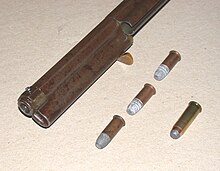
Loading sleeve open, three Henry Flat cartridges, compare with .44 WCF circular

Diagram of the Spencer rifle showing the tubular magazine in the butt
The offset successful mass-produced repeating weapon to utilise a "tubular magazine" permanently mounted to the weapon was the Austrian Army's Girandoni air rifle, starting time produced in 1779.
The beginning mass-produced repeating firearm was the Volcanic Burglarize which used a hollow bullet with the base of operations filled with powder and primer fed into the chamber from a tube called a "magazine" with an integral spring to push the cartridges in to the action, thence to be loaded into the bedroom and fired. Information technology was named after a building or room used to store ammunition. The anemic ability of the Rocket Brawl ammunition used in the Volcanic doomed information technology to limited popularity.[ citation needed ].
The Henry repeating burglarize is a lever-action, breech-loading, tubular magazine fed burglarize, and was an improved version of the earlier Volcanic rifle. Designed by Benjamin Tyler Henry in 1860, it was one of the first firearms to employ self-independent metal cartridges. The Henry was introduced in the early on 1860s and produced through 1866 in the United States past the New Haven Arms Company. It was adopted in small-scale quantities by the Union in the Civil War and favored for its greater firepower than the standard issue carbine. Many later found their style W and was famed both for its use at the Battle of the Piffling Bighorn, and beingness the basis for the iconic Winchester rifle which are still fabricated to this solar day.[11] The Henry and Winchester rifles would keep to encounter service with a number of militaries including Turkey. Switzerland and Italian republic adopted similar designs.[11]
The 2nd magazine-fed firearm to achieve widespread success was the Spencer repeating rifle, which saw service in the American Civil War. The Spencer used a tubular magazine located in the barrel of the gun instead of under the barrel and it used new rimfire metal cartridges. The Spencer was successful, just the rimfire ammunition did occasionally ignite in the magazine tube and destroy the magazine. It could also hurt the user.
The new bolt-activeness rifles began to proceeds favor with militaries in the 1880s and were often equipped with tubular magazines. The Mauser Model 1871 was originally a single-shot action that added a tubular magazine in its 1884 update. The Norwegian Jarmann M1884 was adopted in 1884 and also used a tubular magazine. The French Lebel Model 1886 rifle also used 8-round tubular mag.[12]
Integral box [edit]

1905 Military Rifles magazines.
1 & 2: Mosin–Nagant M1891
three & four: Lebel M1886
5 & half-dozen: Gewehr M1888
7 & 8: Mannlicher M1888
9 & 10: Lee–Metford M1888
11 & 12: Dutch-Mannlicher M1895
thirteen & 14: Mauser M1893
xv: Krag–Jørgensen M1886
16: Schmidt–Rubin M1889
The military cartridge was evolving as the magazine rifle evolved. Cartridges evolved from large-bore cartridges (.twoscore caliber/ten mm and larger) to smaller bores that fired lighter, higher-velocity bullets and incorporated new smokeless propellants. The Lebel Model 1886 burglarize was the first rifle and cartridge to be designed for use with smokeless powder and used an 8 mm wadcutter-shaped bullet that was drawn from a tubular magazine. This would later get a problem when the Lebel's armament was updated to employ a more than aerodynamic pointed bullet. Modifications had to be fabricated to the centerfire instance to prevent the spitzer point from igniting the primer of the next cartridge inline in the magazine through recoil or simply rough treatment.[xiii] This remains a concern with lever-action firearms today.
Ii early box magazine patents were the ones by Rollin White in 1855 and William Harding in 1859.[14] A detachable box magazine was patented in 1864 by the American Robert Wilson. Unlike subsequently box magazines this mag fed into a tube magazine and was located in the stock of the gun.[xv] [16] Another box magazine, closer to the modern type, was patented in Great britain (No. 483) by Mowbray Walker, George Henry Money and Francis Little in 1867.[17] James Paris Lee patented a box mag which held rounds stacked vertically in 1879 and 1882 and information technology was commencement adopted by Austria in the grade of an 11mm straight-pull bolt-action burglarize, the Mannlicher M1886. Information technology as well used a cartridge prune which held v rounds ready to load into the mag.[thirteen] [18]
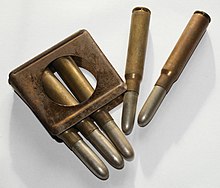
En bloc clip and 8mm ammo for the Gewehr 88
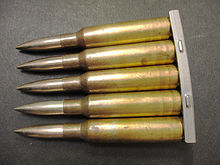
Swedish Mauser stripper clip loaded with Swedish 6.5×55mm
The bolt-action Krag–Jørgensen burglarize, designed in Norway in 1886, used a unique rotary magazine that was built into the receiver. Like Lee's box magazine, the rotary mag held the rounds side-by-side, rather than end-to-finish. Like most rotary magazines, it was loaded through a loading gate one round at a time, this one located on the side of the receiver. While reliable, the Krag–Jørgensen'south magazine was expensive to produce and irksome to reload. It was adopted by but three countries, Kingdom of denmark in 1889, the The states in 1892,[19] and Norway in 1894.
Clip-fed revolution [edit]
A clip (called chargers in the United Kingdom) is a device that is used to store multiple rounds of ammunition together equally a unit, set up for insertion into the magazine or cylinder of a firearm. This speeds up the process of loading and reloading the firearm equally several rounds can exist loaded at one time, rather than one round being loaded at a time. Several different types of clips exist, most of which are made of inexpensive metallic stampings that are designed to be disposable, though they are often re-used.
The start clips used were of the en bloc multifariousness, developed by Ferdinand Mannlicher and first adopted past the Austro-Hungarian Ground forces, which would be used Austro-Hungarians during the first world war in the form of the Mannlicher M1895, derivatives of which would exist adopted by many national militaries. The Germans used this system for their Model 1888 Commission Rifle, featuring a 5-round en bloc prune-fed internal box magazine.[xx] One problem with the en bloc organisation is that the firearm cannot exist practically used without a fix supply of (mosty disposable) clips. Paul Mauser would solve this problem by introducing a stripper clip that functioned only to aid the user in loading the magazine quickly: it was non required to load the magazine to full chapters. He would proceed to make improved models of rifles that took advantage of this new clip design from 1889 through 1898 in various calibers that proved enormously successful, and were adopted past a wide range of national militaries.[13] In 1890 the French adopted the 8mm Lebel Berthier rifles with 3-round internal magazines, fed from en bloc clips; the empty clips were pushed from the bottom of the activeness by the insertion of a loaded prune from the peak.[21] [22]
In the tardily 1800s there were many short-lived designs, such as the M1895 Lee Navy and Gewehr 1888, eventually replaced by the M1903 Springfield burglarize and Gewehr 98 respectively. The Russian Mosin–Nagant, adopted in 1891, was an exception. It was non revolutionary; information technology was a bolt-activity rifle, used a small-diameter smokeless powder cartridge, and a stock-still box magazine loaded from the top with stripper clips, all of which were features that were used in earlier military rifles. What fabricated the Nagant stand out was that it combined all the earlier features in a form that was to last virtually unchanged from its consequence by Russia in 1894 through World War 2 and with its sniper burglarize variants nonetheless in use today.
Magazine cut-off [edit]
An interesting feature of many late 19th- and early 20th-century bolt-activity rifles was the mag cut-off, sometimes chosen a feed interrupter. This was a mechanical device that prevented the rifle from loading a round from the magazine, requiring the shooter to manually load each individual circular equally he fired, saving the rounds in the mag for short periods of rapid burn down when ordered to utilize them. Near military authorities that specified them causeless that their riflemen would waste material ammunition indiscriminately if allowed to load from the magazine all the time.[23] By the mid-20th century, most manufacturers deleted this characteristic to salve costs and manufacturing fourth dimension; it is also likely that battlefield experience had proven the futility of this philosophy.
Final stock-still-mag developments [edit]
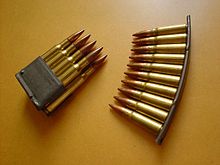
Comparison of M1 Garand en bloc prune (left), and SKS stripper prune (right)
I of the last new clip-fed, fixed-magazine rifles widely adopted that was not a modification of an before rifle was the M1 Garand. The first semi-automated rifle that was issued in large numbers to the infantry, the Garand was fed by a special eight-round en bloc clip. The clip itself was inserted into the rifle'south mag during loading, where it was locked in place. The rounds were fed directly from the clip, with a spring-loaded follower in the rifle pushing the rounds up into feeding position. When empty, the bolt would lock open up, and a jump would automatically eject the empty prune with a distinctive pinging sound, leaving the burglarize ready to be reloaded. The M14 rifle, which was based on incremental changes to the Garand action, switched to a detachable box magazine.[24] However, the M14 with mag attached could besides be loaded via 5-circular stripper-clips.[25]
The Soviet SKS carbine, which entered service in 1945, was something of a stopgap between the semi-automatic service rifles existence developed in the period leading upwards to World War Two, and the new assault burglarize developed past the Germans. The SKS used a fixed mag, holding ten rounds and fed by a conventional stripper clip. It was a modification of the earlier AVS-36 rifle, shortened and chambered for the new reduced power 7.62×39mm cartridge. It was rendered obsolete for military machine apply almost immediately past the 1947 introduction of the magazine-fed AK-47 assault rifle, though it remained in service for many years in Soviet Bloc nations alongside the AK-47. The detachable mag rapidly came to boss postal service-war armed services rifle designs.[26]
Detachable box magazines [edit]

Firearms using detachable magazines are made with an opening known as a magazine well into which the detachable mag is inserted. The mag well locks the mag in position for feeding cartridges into the chamber of the firearm, and requires a device known as a magazine release to let the mag to be separated from the firearm.[27]
The Lee–Metford rifle, developed in 1888, was i of the first rifles to use a detachable box magazine, though this was but detachable for cleaning and not swapped to reload the weapon.[28] All the same, the first completely modern removable box magazine was patented in 1908 by Arthur Savage for the Barbarous Model 99 (1899).[29] Other guns did not adopt all of its features until his patent expired in 1942: It has shoulders to retain cartridges when it is removed from the rifle. It operates reliably with cartridges of different lengths. It is insertable and removable at any time with any number of cartridges. These features allow the operator to reload the gun infrequently, bear magazines rather than loose cartridges, and to hands change the types of cartridges in the field. The mag is assembled from inexpensive stamped sail metal. It likewise includes a crucial rubber characteristic for hunting dangerous game: when empty the follower[30] stops the commodities from engaging the sleeping accommodation, informing the operator that the gun is empty earlier any attempt to fire.
The first successful semi-automatic pistol was the Borchardt C-93 (1893) and incorporated detachable box magazines. Nearly all subsequent semiautomatic pistol designs adopted detachable box magazines.[27]
The Swiss Regular army evaluated the Luger pistol using a detachable box magazine in 7.65×21mm Parabellum and adopted it in 1900 every bit its standard sidearm. The Luger pistol was accepted by the Imperial German language Navy in 1904. This version is known every bit Pistole 04 (or P.04). In 1908 the German Army adopted the Luger to replace the Reichsrevolver in front-line service. The Pistole 08 (or P.08) was chambered in 9×19mm Parabellum. The P.08 was the usual side arm for High german Regular army personnel in both World Wars.
The M1911 semi-automatic pistol set the standard for virtually modern handguns and besides the mechanics of the handgun magazine. In most handguns the magazine follower engages a slide-end to hold the slide dorsum and keep the firearm out of bombardment when the mag is empty and all rounds fired. Upon inserting a loaded magazine, the user depresses the slide stop, throwing the slide forwards, stripping a circular from the pinnacle of the mag stack and chambering it. In single-activeness pistols this action keeps the hammer cocked back equally the new round is chambered, keeping the gun ready to begin firing again.
During World War Ane, detachable box magazines institute favor, existence used in all mode of firearms, such equally pistols, lite-car guns, submachine guns, semi-automatic and automated rifles. However, afterward the State of war to End All Wars, military planners failed to recognize the importance of automated rifles and detachable box magazine concept, and instead maintained their traditional views and preference for clip-fed bolt-action rifles. As a outcome, many promising new automated burglarize designs that used detachable box magazines were abandoned.
As World War II loomed, near of the world'due south major powers began to develop submachine guns fed by 20- to 40-circular detachable box magazines. Nonetheless, of the major powers, just the United States would prefer a full general-issue semi-automated rifle that used detachable box magazines: the M1 carbine with its xv-round magazines. As the war progressed the Germans developed the Sturmgewehr 44 assault rifle concept with its 30-round detachable magazine. After WWII, automatic weapons using detachable box magazines were developed and used past all of the world's armies. Today, detachable box magazines are the norm and they are so widely used that they are simply referred to as magazines or "mags" for brusque.
Part and types [edit]

SKS internal box magazine.

Detachable box mag for a SIG SG 550 with studs for stacking multiple magazines together.
All cartridge-based unmarried-barrel firearms designed to fire more than a single shot without reloading require some form of magazine designed to store and feed cartridges to the firearm's action. Magazines come in many shapes and sizes, with the most common type in modern firearms being the detachable box type. Most magazines designed for apply with a reciprocating bolt firearm (tube fed firearms being the exception) make use of a set of feed lips which stop the vertical motion of the cartridges out of the magazine but let one cartridge at a time to be pushed forward (stripped) out of the feed lips by the firearm's bolt into the chamber. Some form of spring and follower combination is about e'er used to feed cartridges to the lips which tin can be located either in the mag (near removable box magazines) or built into the firearm (fixed box magazines). At that place are too ii distinct styles to feed lips. In a unmarried-feed design the tiptop cartridge touches both lips and is ordinarily used in single-cavalcade box magazines, while a staggered feed magazine (sometimes called double-feed magazine, not to be confused with the firearm malfunction) consists of a wider gear up of lips so that the second cartridge in line forces the top cartridge against one lip. This design has proven more resistant to jamming in utilise with double-column magazines.[31] Some magazine types are strongly associated with sure firearm types, such as the fixed "tubular" mag institute on nearly lever-activity rifles and pump-activeness shotguns. A firearm using detachable magazines may accept a variety of types of magazine, such equally the Thompson submachine gun, nigh variations of which would accept box or drum magazines. Some types of firearm, such every bit the M249 and other squad automated weapons, can feed from both magazines and belts.
Tubular [edit]
Many of the outset repeating rifles, specially lever-action rifles, used magazines that stored cartridges olfactory organ-to-finish inside of a spring-loaded tube typically running parallel nether the butt, or in the buttstock. Tubular magazines are likewise usually used in pump-action shotguns and .22 caliber bolt-action rimfire rifles such as the Marlin Model XT. Tubular magazines and centerfire cartridges with pointed (spitzer) bullets present a safety issue: a pointed bullet may (through the forces of recoil or simply rough handling) strike the side by side round's primer and ignite that circular, or even cause a chain ignition of other rounds, within the magazine. The Winchester '73 used edgeless-nosed centerfire cartridges equally the .44-40 Winchester. Certain mod burglarize cartridges using soft pointed plastic tips accept been designed to avoid this problem while improving the aerodynamic qualities of the bullet to match those available in bolt-activeness designs, thus extending the constructive range of lever-actions.
Box [edit]


Single column (aka single-stack) and staggered (aka double-stack) cavalcade detachable box magazines, both with single-feed lips.
The most popular blazon of magazine in modernistic rifles and handguns, a box magazine stores cartridges in a column, either i above the other or in staggered zigzag style. This zigzag stack is often identified as a double-column or double-stack (The double-stack is much more mutual because of its ability to store more rounds), since a single staggered cavalcade is actually two side-by-side vertical columns starting time by half of the diameter of a round. As the firearm cycles, cartridges are moved to the top of the mag past a follower driven by bound compression to either a unmarried-feed position or side-by-side feed positions. Box magazines may be integral to the firearm or removable.
- An internal box, integral box or stock-still magazine (besides known as a blind box magazine when defective a floorplate) is congenital into the firearm and is non hands removable. This type of magazine is found about ofttimes on bolt-action rifles. An internal box magazine is commonly charged through the action, ane round at a fourth dimension. Military rifles often apply stripper clips, a.k.a. chargers, permitting multiple rounds, commonly 5 or 10 at a time, to be loaded in rapid sequence. Some internal box magazines use en bloc clips that are loaded into the magazine with the ammunition and that are ejected from the firearm when empty.
- A detachable box magazine is a self-independent mechanism capable of being loaded or unloaded while discrete from the host firearm. They are attached via a slot in the firearm receiver, usually beneath the activeness (BAR, MP forty, AK 47, and M16), to the side of the action, (Sten, FG 42, Johnson LMG, Sterling, and M249) or on top of the activity (Madsen machine gun, Bren gun, Owen gun, and P90). When necessary, the magazine can hands be detached from the firearm and replaced past another. This significantly speeds the process of reloading, allowing the operator quick access to armament. This type of magazine may be direct or curved, the bend being necessary if the burglarize uses rimmed armament or ammunition with a tapered instance. Detachable box magazines may exist metallic or plastic. The plastic magazines are sometimes partially transparent and then the operator tin hands bank check the remaining ammunition. Box magazines are often affixed to each other with clamps, clips, tape, straps, or congenital-in studs to facilitate faster reloading: see jungle style.
There are, yet, exceptions to these rules. The Lee–Enfield rifle had a detachable box magazine only to facilitate cleaning. The Lee–Enfield mag did open up, permitting rapid unloading of the magazine without having to operate the commodities-action repeatedly to unload the magazine. Others, like the Breda Modello xxx, had a fixed protruding magazine that resembled a conventional detachable box just was non-detachable.
Horizontal [edit]


The P90's magazine has a capacity of l rounds, and information technology fits flush with the weapon's frame.[32]
The FN P90 and Kel-Tec P50 personal defence weapons use horizontally mounted feeding systems. The magazine sits parallel to the butt, fitting flush with the meridian of the receiver, and the ammunition is rotated 90 degrees past a spiral feed ramp before being chambered. The Heckler & Koch G11, an experimental set on burglarize that implements caseless ammunition, as well functions similarly with the magazine aligned horizontally over the barrel. Rather than being positioned laterally to the barrel like with the aforementioned examples, ammunition is positioned vertically with the bullet facing downward at a ninety degree bending relative to the barrel where it is fed into a rotary chamber earlier firing. The AR-57, also known as the AR Five-vii, is an upper receiver for the AR-15/M16 burglarize lower receiver, firing FN 5.vii×28mm rounds from standard FN P90 magazines.
Casket [edit]

Diagram of the Spectre M4 casket magazine
Another form of box magazine, sometimes referred to as a "quad-column", tin concord a large corporeality of ammunition. Information technology is wider than a standard box mag, but retains the same length. Casket magazines can be institute on the Suomi KP/-31, Hafdasa C-4, Spectre M4, QCW-05 and on 5.45×39mm AK burglarize derivatives. Magpul has been granted a patent[33] for a STANAG-compatible casket magazine,[34] and such a magazine was likewise debuted past SureFire in December 2010, and is at present sold as the MAG5-60 and MAG5-100 high capacity magazine (HCM) in lx and 100 round capacities, respectively, in 5.56mm for AR-fifteen compatible with M4/M16/AR-fifteen variants and other firearms that accept STANAG 4179 magazines.[35] Izhmash has likewise developed a casket magazine for the AK-12.[34]
Rotary [edit]

The rotary (or spool) magazine consists of a cylindrical sprocket actuated past a torsion spring, with cartridges plumbing equipment between the tooth bar of the sprocket, which is mounted on a spindle parallel to the diameter centrality and rotates each circular sequentially into the feeding position. Rotary magazines may be fixed or detachable, and are ordinarily of low capacity under x rounds, depending on the caliber used. John Smith patented a rotary mag in 1856.[36] [37] Another rotary mag was produced past Sylvester Roper in 1866 and was also used in the weapons by Anton Spitalsky and the Savage Model 1892.[38] [39] The M1941 Johnson rifle also uses a rotary mag. The pattern is still used in some modernistic firearms, most notably the Ruger American series, the semi-automatic Ruger 10/22, the bolt-action Ruger 77/22 and the Steyr SSG 69.
Drum [edit]
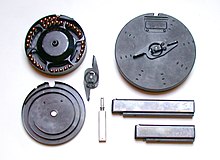
50- and 100-round drum magazines plus xx- and 30-round box magazines for Thompson SMG
Drum magazines are used primarily for light motorcar guns. In 1 type, a moving segmentation within a cylindrical chamber forces loose rounds into an go out slot, with the cartridges beingness stored parallel to the axis of rotation. After loading of the magazine, a wound spring or other mechanism forces the partition against the rounds. In all models a single staggered column is pushed by a follower through a curved path. From at that place the rounds enter the vertical riser either from a single or dual drums. Cylindrical designs such as rotary and pulsate magazines allow for larger chapters than box magazines, without growing to excessive length. The downside of a pulsate magazine'southward extra capacity is its added weight that, combined with the gun, tin touch handling and prolonged use. Drum magazines can be more difficult to contain into combat gear compared to more than regular, rectangular box magazines.
Many drum-fed firearms tin also load from conventional box magazines, such as the Soviet PPSh-41 submachine gun, RPK light machine gun and the American Thompson submachine gun.
The term "drum" is sometimes applied to a belt box for a belt-fed machine gun, though this is just a case that houses a length of armament chugalug, non a drum magazine.
![]() Media related to Drum magazines at Wikimedia Eatables
Media related to Drum magazines at Wikimedia Eatables
Saddle-drum [edit]

Beta C-Mag double-pulsate magazine.
Before WWII the Germans adult 75-round saddle-drum magazines for employ in their MG thirteen and MG fifteen machine guns. The MG 34 machine guns could likewise use saddle-pulsate magazine when fitted with a special feed encompass. The 75 rounds of ammunition were evenly distributed in each side of the magazine with a central feed "belfry" where the armament is fed to the bolt. The armament was fed by a leap force, with rounds alternating from each side of the double drum and then that the gun would non get unbalanced.
Pan [edit]

Pan magazine as used on a seven.92mm Lewis Gun.
The pan magazine differs from other circular magazines in that the cartridges are stored perpendicular to the axis of rotation, rather than parallel, and are usually mounted on meridian of the firearm. This type is used on the Lewis Gun, Vickers Chiliad, Bren Gun (only used in anti-aircraft mountings),[40] Degtyaryov low-cal car gun, and American-180 submachine gun. A highly unusual case was plant on the Type 89 machine gun fed from two 45-round quadrant-shaped pan magazines (each magazine had a place for 9 5-circular stripper clips).
![]() Media related to Pan magazines at Wikimedia Eatables
Media related to Pan magazines at Wikimedia Eatables
Helical [edit]

Calico pioneered the helical magazine pattern. Pictured is the company's M960 carbine.
Helical magazines extend the drum mag blueprint then that rounds follow a spiral path around an auger-shaped rotating follower or drive member, allowing for large ammunition chapters in a relatively meaty package (compared to a regular box magazine of similar capacity). Early helical magazine designs include that patented by an unidentified inventor through the patent amanuensis William Edward Newton in 1857 and the internal mag of the Evans Repeating Burglarize, patented in the tardily 1860s.[41] [42] This type of magazine is used by the Calico M960, PP-xix Bizon, CS/LS06 and KBP PP90M1. The North Korean military uses a 100- to 150- round helical magazine in the Type 88 assault rifle.[43] Helical magazines offer essentially more ammunition carriage, however they are inherently complex designs. Equally such, they tin can be hard to load and may subtract the reliability of feeding the weapon.[41]
STANAG magazine [edit]

Two STANAG-compliant magazines: A xx-round Colt-manufactured magazine, and a 30-round Heckler & Koch "high reliability" magazine.
A STANAG magazine [44] [45] or NATO magazine is a blazon of detachable mag proposed by NATO in October 1980.[46] Presently afterward NATO'due south acceptance of the 5.56×45mm NATO burglarize cartridge, Draft Standardization Agreement (STANAG) 4179 was proposed in order to allow NATO members to easily share burglarize ammunition and magazines downwards to the individual soldier level. The U.S. M16 rifle magazine was proposed for standardization. Many NATO members subsequently adult or purchased rifles with the power to have this type of magazine. Nonetheless, the standard was never ratified and remains a "Draft STANAG".[47]
The STANAG magazine concept is merely an interface, dimensional, and control (magazine latch, commodities stop, etc.) requirement.[48] [49] Therefore, it not but allows one type of magazine to interface with various weapon systems,[48] [49] but also allows STANAG magazines to be fabricated in various configurations and capacities.[48] [49] The standard STANAG magazines are 20, 30, and forty round box magazines,[49] only there are many other designs available with capacities ranging from 1 circular[fifty] to 60 and 100 circular casket magazines,[51] [52] 90 round snail-drum magazines,[53] and 100 round[54] and 150 round double-drum magazines.[55]
High-capacity magazines [edit]
In the United states of america, a number of states take passed laws that ban magazines which are defined as "high-capacity" by statute.[56] High-capacity or large-chapters magazines are generally those defined by statute to be capable of holding more 10 to fifteen rounds, although the definitions vary.[56] [57] [58] Other nations impose restrictions on mag capacity as well. In Canada, magazines are more often than not express to five rounds for rifles and ten for handguns (with some exceptions), depending on the firearm.[59]
See too [edit]
- Chugalug (firearms)
- Lesser metal
- Jungle way (firearm magazines)
- List of 3D printed weapons and parts
References [edit]
- ^ "NRA Firearms Glossary". National Rifle Association. Archived from the original on 2011-07-eighteen. Retrieved 2008-06-26 .
- ^ a b "Gun Zone clips vs. magazines". The Gun Zone. Archived from the original on 2008-07-20. Retrieved 2008-06-26 .
- ^ "Handgunner's Glossary". Handguns Annual Magazine, 1994. Retrieved 2013-03-21 .
- ^ United States Regular army, American Expeditionary Force (1917). Provisional Instruction on the Automatic Burglarize, Model 1915 (Chauchat). Reprinted past the ArmyWar College. , translated from the French edition, 1916
- ^ United States Ordnance Dept. (1917). Description of the Automated Pistol, Caliber .45, Model of 1911. Govt. print. off.
- ^ United States War Dept (1907). Almanac Reports of the Secretarial assistant of War.
- ^ "Magazine". SAAMI. Archived from the original on 2008-04-09. Retrieved 2008-06-26 .
- ^ "Cartridge Clip". SAAMI. Archived from the original on 2008-04-09. Retrieved 2008-06-26 .
- ^ "Firearms Glossary". National Rifle Association. Archived from the original on 2011-07-xviii.
- ^ Charles Winthrop Sawyer (1920). Firearms in American History, volume Three. Cornhill Company, Boston. [ page needed ]
- ^ Military Small-scale Artillery Of The 20th Century, seventh Edition, 2000 by Ian V. Hogg & John Due south. Weeks, p.179-180
- ^ a b c Seton-Karr, Henry (1911). . In Chisholm, Hugh (ed.). Encyclopædia Britannica. Vol. 23 (11th ed.). Cambridge University Press. pp. 325–336.
- ^ "Abridgments of the Specifications Relating to Fire-arms and Other Weapons, Ammunition, and Accoutrements: Printed by Order of the Commissioners of Patents". George E. Eyre and William Spottiswoode, pub. at the Bang-up seal patent office. 27 October 1870. p. 72.
- ^ Jaroslav Lugs. A complete review of firearm systems and their histories.
- ^ "Improvement in self-loading burn-arms". Google.com . Retrieved 5 June 2017.
- ^ Westwood, David (2005). Rifles: An Illustrated History Of Their Impact. US: ABC-CLIO. p. 94. ISBN978-1851094011.
- ^ Chamber'south Encyclopaedia: A Dictionary of Universal Noesis. West. & R. Chambers. 1891. pp. 720–721.
- ^ United states of america Ground forces Ordnance Department (1898). Description and Rules for the Management of the U.S. Magazine Rifle and Carbine. p. 36.
- ^ Military machine Minor Arms Of The 20th Century, 7th Edition, 2000 past Ian V. Hogg & John Due south. Weeks, p.184
- ^ War machine Small-scale Arms Of The 20th Century, seventh Edition, 2000 by Ian V. Hogg & John Southward. Weeks, p.180
- ^ Chuck Hawks. "The 8x50R Lebel (8mm Lebel)". Chuckhawks.com . Retrieved 2017-06-05 .
- ^ "Firearms Technical Trivia: Magazine cut-offs". Cruffler.com. Feb 2000.
- ^ "Modernistic Firearms - M14". Globe.guns.ru. Archived from the original on 15 August 2010. Retrieved five June 2017.
- ^ Rottman, Gordon L (2013). The Book of Gun Trivia: Essential Firepower Facts. Bloomsbury Publishing. ISBN978-1-78200-620-vi.
- ^ "Modernistic Firearms - SKS Simonov". world.guns.ru. Archived from the original on 2 September 2010. Retrieved v June 2017.
- ^ a b Dark-brown, Edmund G. (2009). Handgun Condom Certificate. W Sacramento, California: California Department of Justice. p. 52.
- ^ Military Small Arms of the 20th Century, 7th Edition, 2000, by Ian 5. Hogg & John South. Weeks, p. 187
- ^ U.Due south. Patent 885,868, April 28, 1908, Improved Magazine, Inventor: Arthur W. Brutal.
- ^ The "follower" is the sheet metal part betwixt the last cartridge and the spring. It might be made of or coated with other materials such as nylon or Teflon.
- ^ Weeks, John, Earth War II Modest Artillery, London: Orbis Publishing Ltd. (1979), p. 33.
- ^ Kevin, Dockery (2007). Future Weapons. New York: Berkley Trade. ISBN978-0-425-21750-four.
- ^ U.Southward. Patent 8,061,071
- ^ a b "Magpul Invents New Quad-Stack Mag for ARs « Daily Message". bulletin.accurateshooter.com . Retrieved five June 2017.
- ^ Crane, David (December 3, 2010). "DR Exclusive!: SureFire MAG5-60 and MAG5-100 High Chapters Magazine (HCM) "Quad-Stack" AR Burglarize Magazines: threescore-Round/Shot and 100-Round/Shot AR (AR-15/M16) 5.56mm NATO Box Magazines for Significantly-Increased Firepower during Infantry Combat and Tactical Engagements of All Sorts". DefenseReview.com. Archived from the original on January four, 2011.
- ^ "Bibliographic data". Depatisnet.dpma.de . Retrieved 5 June 2017.
- ^ "Improvement in repeating mag burn down-artillery".
- ^ Lee, Jerry (xv July 2013). Gun Digest 2014. Gun Digest Books. p. 61. ISBN978-ane-4402-3550-four.
- ^ U.S. Patent 502,018, Magazine Gun, Awarding date: April 10, 1889, Effect date: July 25, 1893, Inventor: Arthur Westward. Barbarous
- ^ "Photographic image" (JPG). Cairdpublications.com . Retrieved 2017-06-05 .
- ^ a b Jenzen-Jones, Due north.R. (28 August 2019). "Chinese CS/LS06 'Chang Feng' sub-car gun – Ammunition Research Services". Armament Inquiry Services . Retrieved 2019-09-18 .
- ^ "English language Patents of Inventions, Specifications: 1857, 309 - 385". 1857.
- ^ "Due north Korean Helical AK Magazines – Armament Enquiry Services". 4 February 2014. Retrieved 2019-09-xviii .
- ^ The M16, Gordon L. Rottman, © Osprey Publishing, 2011, Page 35-36
- ^ Time to come Weapons, Kevin Dockery, © Penguin, 2007, Page 125-126
- ^ Watters, Daniel: "The 5.56 X 45mm Timeline: A Chronology of Evolution Archived 2015-03-16 at the Wayback Machine", The Gun Zone, 2000–2007.
- ^ "NATO Infantry Weapons Standardization Archived 2012-12-01 at the Wayback Car", NDIA Briefing 2008
- ^ a b c Dockery, Kevin (five June 2017). Future Weapons. Penguin. p. 125. ISBN978-0-425-21750-four.
- ^ a b c d Rottman, Gordon L. (20 October 2013). The Book of Gun Trivia: Essential Firepower Facts. Bloomsbury Publishing. p. 147. ISBN978-one-78200-620-half dozen.
- ^ "Sinclair International AR-15/M16 Unmarried Shot Magazine Follower". www.sinclairintl.com. Sinclair Intl. Retrieved April 27, 2019.
- ^ "Magpul Invents New Quad-Stack Magazine for ARs « Daily Bulletin". Message.accurateshooter.com . Retrieved 15 November 2014.
- ^ David Crane (iii Dec 2010). "DR Exclusive!: SureFire MAG5-sixty and MAG5-100 High Capacity Mag (HCM) "Quad-Stack" AR Rifle Magazines: lx-Round/Shot and 100-Circular/Shot AR (AR-fifteen/M16) five.56mm NATO Box Magazines for Significantly-Increased Firepower during Infantry Combat and Tactical Engagements of All Sorts". DefenseReview.com (DR): An online tactical applied science and armed forces defense force technology magazine with item focus on the latest and greatest tactical firearms news (tactical gun news), tactical gear news and tactical shooting news . Retrieved xv November 2014.
- ^ "MWG ninety-Rounder Snail Drum Magazine: 90 Rounds of Firsthand 5.56mm Firepower for Your M4/M4A1 Carbine (or AR-15 Carbine)". Defensereview.com . Retrieved five June 2017.
- ^ The Gun Digest Book of the AR-fifteen. Patrick Sweeney. Gun Digest Books, September ix, 2005. folio 106
- ^ "SAW-MAG – Armatac Industries". armatac.com.
- ^ a b "Large Chapters Ammunition Magazines Policy Summary". smartgunlaws.org. Law Eye to Prevent Gun Violence. May 31, 2013. Retrieved May 25, 2014.
- ^ Rose, Veronica (Jan 24, 2013). "Laws on Loftier Capacity Magazines". cga.ct.gov. Connecticut Full general Associates. Retrieved Apr 9, 2014.
- ^ "Archived copy". Archived from the original on 2014-12-24. Retrieved 2014-07-12 .
{{cite web}}: CS1 maint: archived copy as championship (link) - ^ "Maximum Permitted Magazine Capacity". Special Bulletin for Businesses No. 72. Royal Canadian Mounted Police. 2014-12-08. Retrieved 28 January 2015.
Further reading [edit]
- The Franklin Institute (February 1970). "Component Design" (PDF). Automatic Weapons. Engineering science Blueprint Handbook: Guns. U.S. Army Materiel Control. pp. 7-2 through 7-9. AMCP 706-260.
External links [edit]
- Departure Between a Magazine and a Prune video
- Divergence Between a Magazine and a Clip – Picture
What Size Magazine Was Used In Florida Shooting,
Source: https://en.wikipedia.org/wiki/Magazine_(firearms)
Posted by: smithmandis.blogspot.com


0 Response to "What Size Magazine Was Used In Florida Shooting"
Post a Comment